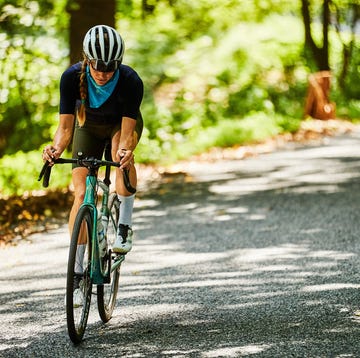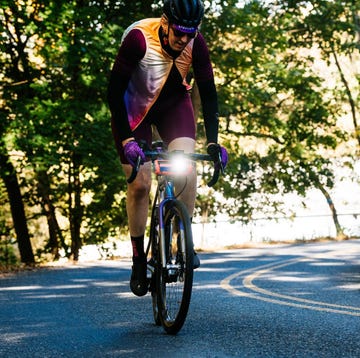There are all types of bikes (trail, gravel, road) and all kinds of rides (bikepacking trips, races, charity events), but there is one ride that serves as an iconic milestone for almost every cyclist: the century ride.
Whether you’re a seasoned cyclist looking to check off a bucket list achievement or you’re new to the sport and curious about this much-talked-about goal, considering tackling a century ride can feel both exhilarating and intimidating.
We’re here to answer all your questions about this thrilling accomplishment that tests physical and mental endurance, including exactly what is a century ride, what training for one is like, and what else to know before you start pedaling.
What is a century ride?
A century ride is a 100-mile bike ride. For many cyclists, the appeal lies in its clear, measurable goal: Get to those triple digits in one ride.
The average time it takes riders to complete 100 miles ranges from just over five and a half hours to more than seven hours, according to Strava, but your fitness level, route, and how many stops you take will all play into the duration of your ride. Unexpected events, such as flats and bad weather, can also lengthen your ride.
Whatever the outcome, training and planning for a triple-digit challenge offers a sense of accomplishment in itself, as you’ll work to build endurance, mental toughness, and fine-tune your pacing.
“Century rides are a great way to improve your aerobic endurance,” national champion and coach Luke Vrouwenvelder of LukeV Coaching tells Bicycling. “They often rely on long, steady efforts prioritizing efficiency and endurance over power and strength.”
Besides the fitness aspect, many century rides also have a social element. “Century rides are a fun way to set a goal, ride with a group, and enjoy a route with refueling stops along the way,” Kellie Moylan, USA Cycling Level 1 and Expert Coach for CarmichaCel Training Systems tells Bicycling. This mix of personal achievement and camaraderie keeps cyclists coming back for more.
Is a century ride a race?
Century rides are not usually races (more events), so you won’t be riding at your top speed. In fact, pacing the century is one of the most critical factors in completing your ride, and that means starting out slow. Moylan suggests knowing your relaxed pace ahead of time and sticking to it.
Likewise, Vrouwenvelder’s advice is to “start slow and finish fast.” The key is to conserve energy in the first few hours so you have enough left for the ride’s second half. Going out too fast is one of the most common mistakes riders make.
Because the century is one long ride, in order to conquer it, you’ll need to train for your ride by spending a considerable amount of time in the saddle. Specifically, you’ll want to combine multiple rides per week with a regular increase in distance.
You’re also more likely to succeed if you follow a training plan, which will focus not only on cycling, but also strength and recovery to keep you healthy and ready to take on 100.
How long does it take to train for a century ride?
How much time you need to train for a century ride depends on your fitness level, how much you’re already riding, and when your event takes places (among other factors). Our training plans span from four weeks for advanced riders to 20 weeks for those just getting started.
Vrouwenvelder suggests that you start training for a century ride by building on your current longest ride and increasing that distance by about 10 percent each week. For example, if your longest ride is 50 miles, add five miles the first week, 5.5 miles the next, and six the next.
Also, focus on staying consistent with your time in. “The key is to get comfortable spending long hours in the saddle,” Moylan explains.
What should your century ride training plan include?
Your training plan should focus on building endurance and aerobic efficiency with a combination of long rides and interval sessions, focusing on tempo and threshold efforts, says Vrouwenvelder. These will improve your ability to sustain harder efforts over long distances.
Of course, you also need to incorporate rest days and recovery weeks into your schedule to prevent overtraining, says Moylan.
Planning out your century route ahead of training can also help you prepare for event day. You can do a loop so you end up back home where your bed and coach will be waiting, or you can take a long ride to another location and have someone bring you home.
Route planning requires figuring out details, like terrain, places to stop (you may need a bathroom, not to mention a stretch break or three), and maybe even the option to have a meal.
How many century rides should you do in a year?
While the number of century rides you do in a year depends on your goals and fitness level, you also need to take recovery time into account, Vrouwenvelder advises. “Riding a century requires a lot of work, so make sure to leave enough recovery time between rides to avoid overtraining,” he says.
Moylan agrees that for most recreational cyclists, one or two century rides per season are typical. However, some riders may do multiple centuries as part of their training for ultra-cycling events. “It varies from rider to rider, but you should aim to enjoy each ride rather than trying to do too many and burning out,” she says.
What tips should you keep in mind for century ride day?
As mentioned, when you plan the route of your ride, you also need to build in fuel and hydration stops (or at least pauses), as both are crucial for any long-distance ride.
Aim for at least 30 to 60 grams of carbs per hour during your ride (up to even 120 grams per hour). “Eat early and eat often. Getting enough calories is one of the easiest ways to improve your performance,” Vrouwenvelder says. High-carb drink mixes can be a great way to increase calorie intake, but try them during your training to make sure your stomach can handle the mixtures.
Obviously, you’ll want to make sure you carry or have access to enough water on your trip. “Make sure you’re drinking enough water, especially on hot days. Keeping your sodium levels up is key to avoiding cramps and fatigue,” Moylan says.
Most importantly: “Keep it fun! Don’t get too caught up in the numbers. At the end of the day, cycling is about enjoying the ride,” says Moylan.
Jarrod Nobbe is a USAW national coach for the Athletic Lab Weightlifting Club and sports performance coach at Athletic Lab. He holds a BS in Exercise Science and an MA in Sports Performance from Ball State University. Jarrod holds the following certifications: NSCA CSCS, USAW National Coach, EXOS XPS, NSPA CSNC & CWPC, USATFCCCA, Athletic Lab Coaching Academy CHPC L3. When he's not in the gym or at his desk creating content, Jarrod can be found shredding the dirt on the nearest mountain bike trail in preparation for his next enduro race.













